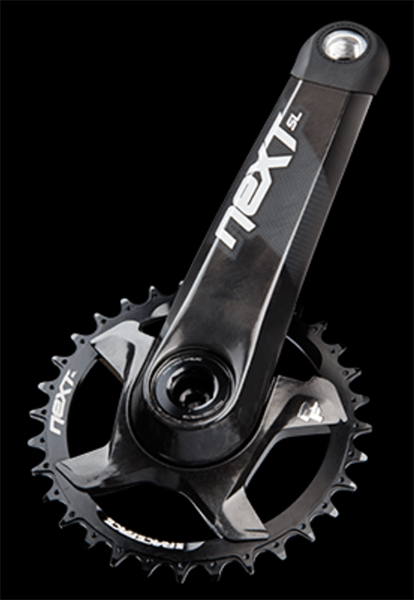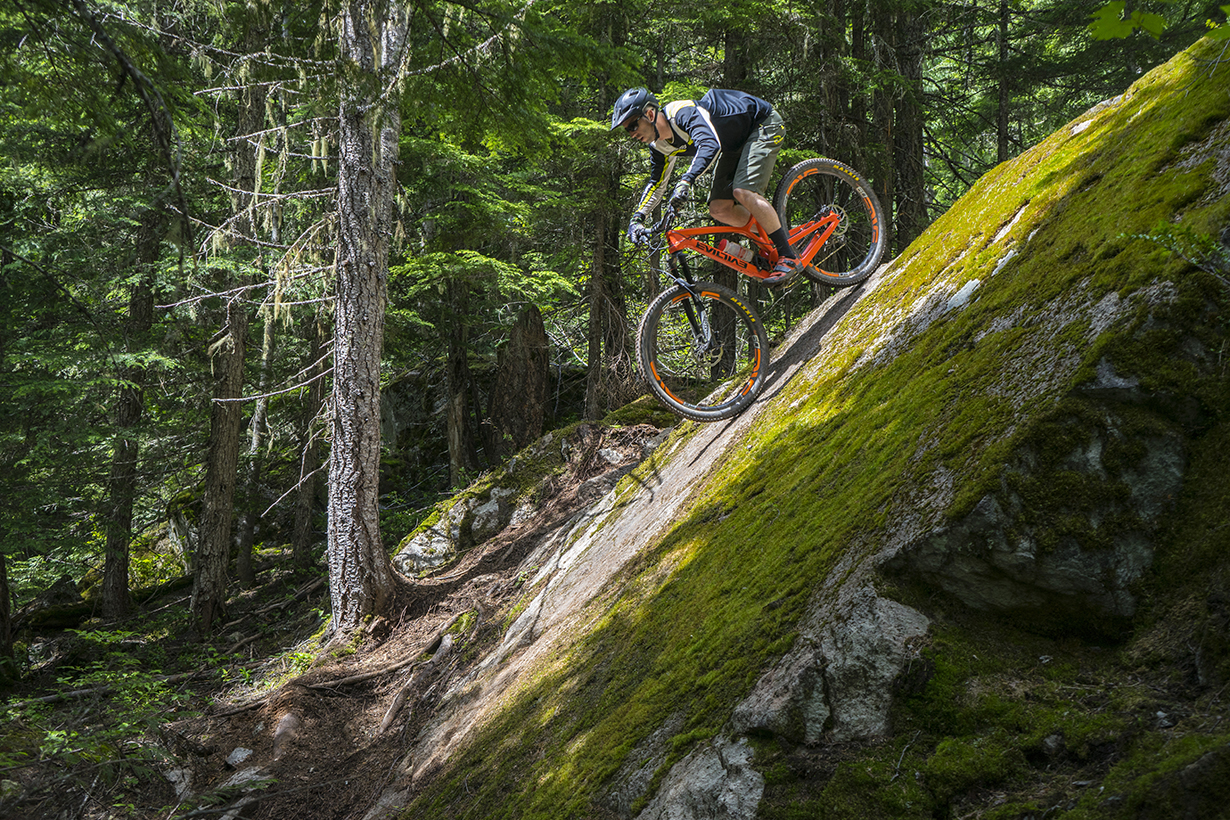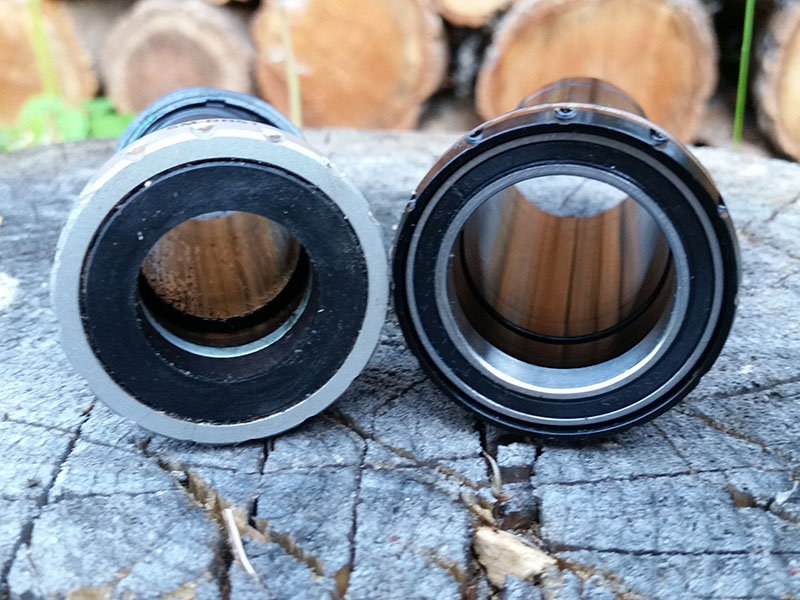
Race Face Next SL G4 Cranks
Intended Use: Cross Country / Trail
Configuration Tested: 170 mm length, PF92 Bottom Bracket, 32t direct mount ring
Blister’s Measured Weight
Cranks with 32t direct mount ring and rubber booties: 441 grams
Bottom Bracket (PF92) 69 grams
Total: 510 grams
MSRP: $549.99 (w/o BB)
Mounted to: 2015 Evil Following
Reviewer: 5’9” 155lbs
Tes Duration: About 2 months
Test Locations: Whitefish, Montana; Whistler, BC
When I’m writing reviews of bike gear, I’ll sometimes come across products that are my personal favorite; for my uses, it works better than anything else I’ve tried. But it’s pretty rare that I’ll declare something to be the “best” – it might work well for me, but maybe there’s some other product that’d work even better for someone else.
But this is one of the very few occasions where I’m willing to declare a winner: I think the Next SL G4 cranks are the best trail cranks on the market right now. They’re not the cheapest, but if I’m shelling out cash to build my trail bike, there is no better option.
So what makes them so great?
The Cinch System
Raceface’s Cinch system has been out for about two years now, and in my review of the SixC cranks last year, I was cautiously optimistic. The upsides of the system are clear: it’s quick and easy to swap out bottom bracket spindles. I personally have converted swapped spindles around on some Race Face cranks to fit different bikes – it’s a quick and easy process, and a hell of a lot cheaper than getting a whole new crankset. And Race Face makes spindles to fit pretty much all common frames on the market, including fat bikes.

It also means that when a large to-remain-nameless company decides to force the bike industry into adopting yet another new and different “standard,” you’ll still be able to use your cranks – all you’ll need is a new spindle (and maybe a new bottom bracket). Race Face calls their cranks “future proof,” which is actually pretty accurate.
My initial cautiousness came from the larger 30 mm spindle that both the Next SL G4 and the SixC cranks use. Yes, that large spindle is stiff and light, but it means the bottom bracket bearings are smaller than those used with other cranksets.

But after a few months on the Next SL G4’s, the better part of two seasons on the SixC’s, and a decent amount of time on various other Race Face Cinch cranksets, my concerns have largely been put to rest. All of my cranks and bottom brackets are still running perfectly smoothly, and that’s with my usual complete disregard for bike maintenance. Yes, I have seen 30 mm Race Face bottom brackets fail, and I’ve heard stories of Race Face bottom brackets prematurely dying, but I’ve also seen plenty of Shimano and SRAM bottom brackets fail prematurely too. The Race Face options aren’t bulletproof, but in my experience, they’re not any worse than anything else on the market. And, like with most other cranksets, a few companies are making aftermarket bottom brackets that will fit the Next SL G4’s 30 mm spindle, so there are options if you have bad luck with stock bottom bracket.
Options
In addition to the variety of spindles available for Cinch cranks, the Next SL G4’s also have the usual assortment of options; 170 mm and 175 mm lengths, and a whole slew of chainring configurations. I ran the cranks with a normal Race Face 30 tooth direct mount chainring, but Race Face also makes a slick composite spider 1x ring, and has spiders to work with 2x and 3x setups. A full table of chainring options, Q-factors, and chainline measurements is available from Race Face here.
Weight vs. Stiffness
Making a heavy, stiff crank is easy. So is making a light flexy one. But Race Face has done a pretty damn good job of making a stiff crank that’s also ridiculously light. I’m not the biggest guy around, nor am I generating impressive levels of torque, so I’ll admit that I don’t need the stiffest crank on the market. That said, I never noticed the Next SL G4’s to be flexy in the slightest. No, they’re not quite as stiff as their burlier cousin, the SixC, but they transferred power as well as any other “trail” crank I’ve tried.
And did I mention they’re light? Because yeah, they’re really light. On my scale, with a 32 tooth direct mount ring attached and with the little rubber protectors installed, they weighed in at a scant 441 grams. For reference, that’s about 80 g less than Shimano XTR cranks, and over 100 g less than SRAM XX1.
The Next SL G4’s are around 15 g lighter than the previous iteration of the Next SL cranks, and Race Face says they’ve increased lateral stiffness as well. I can’t say that I notice the increase in stiffness (or, for that matter, the decrease in weight), but I also wouldn’t say that I found the prior generation to be heavy or especially flexy.
Construction
Carbon cranks are great from a stiffness and weight perspective, but inherent difficulties with the construction mean there are some common failures. The most common that I’ve seen, particularly on SRAM cranks, is that the pedal inserts rip out.
Pretty much all carbon cranks use an aluminum insert that the pedal threads into. The difficulty arises during the manufacturing process; the carbon in the cranks is wrapped around the aluminum insert, and then the carbon needs to be cured with heat and pressure. But when everything cools off, the aluminum insert cools at a different rate than the carbon, and the metal can contract slightly, forming a weaker bond with the carbon.
Race Face came up with a patented process to address this – basically, the aluminum insert is machined in such a way that, as it cools, it locks into the carbon even more tightly.

Race Face’s efforts in making the crank’s construction stronger seems to have worked – I’ve never seen nor heard of a pedal ripping out of a Race Face carbon crank (not to say it’s never happened, but it’s rare). In contrast, I’ve personally witnessed a number of pedals rip out of various carbon SRAM cranks.
NEXT: The Little Things, The Ride, Etc.

Next SL inserts might not come out, but I’ve seen the arms crack-they’re light and as good as carbon gets, but if you’re willing to lug an extra 1/4 pound of weight, Shimano SLX and XT crankarms are the gold standard of durability.
With that said, one of my riding buddies is over 6 1/2 feet tall, 250 pounds and a really strong rider. He can’t use Shimano cranks because the plastic washers between the crankarms and BB bearings get wrecked within a few rides. He’s had the best luck with SRAM X9 arms and GXP bottom brackets.
A couple of other observations-RaceFace narrow/wide rings wear notably fast, and once they’re worn, have no chain retention (luckily there are aftermarket brands that make Cinch-style rings). Shimano’s rings aren’t even narrow-wide, and are super sensitive to chainline. Luckily, many companies also make Shimano BCD rings. SRAM narrow-wide rings work notably well, and seem to hold the chain even when somewhat worn.
Chromag makes rings for other brands with the SRAM tooth profile-if you can get them (they sell out all the time). Wolf Tooth rings also work well and are reasonably durable..
RaceFace carbon arms aren’t worth the money. They pare weight in the one place on a bike (low and centered) where a few extra grams on the bike don’t hurt. Despite the marketing hype, losing 100-150 grams of crank weight won’t make anyone measurably faster. If you weigh 200 pounds or less, run SLX or XT arms with a Wolf-Tooth or Chromag ring. If you’re a bigger beast, SRAM X9 should fit the bill.
I guess if you’re a trust fund weight weeine and everything else on your bike is already carbon, this might be the last piece of bling to finish your $10k build….
Then again, crank and pedal failures tend to be horrific-is it worth shaving that last few grams with carbon crankarms (or ti pedal spindles) that probably won’t fail?
Nice review, Noah. Agrees with most of my observations after a season of thrashing a pair on my Fuel EX 9.9 endurance racing bike. It gets a LOT of hours.
I decided to roll the dice. No booties. No problems.
Stiffness seems on par with the XT I ran last year, and I’m 6’2″ and 195, so there’s that!
Very good life on the RF 32t ring. Not quite great, but very good. No chain retention problems (it helps that Shimano derailleurs allow you to easily increase the clutch tension a bit as things get a bit old and tired).
BB not the best. It’s gotten draggy/almost seized twice on me, but popping the seals, cleaning, drying, and re-lubing with Dumonde blue liquid grease seems to have saved me both times.
I’ll be running this bike for another season. I will probably install a superior BB, and would love your input. I’ve heard great things about Enduro Torque-Tite BBs (as you would hope for a near $200 BB!). I previously had good luck with a Praxis in my old Turner Czar.
I’ve got 3yrs [~7 months/yr riding] on the same Next SL G3 cranks and RF PF 92 BB. BB has been silent and trouble free. Still spins smooth. I check it at the start of every season thinking I’ll need a new one, but so far so good.
Cranks have been smashed into lots of rocks and roots, but despite a few marks they are going strong. I do run the RF silicone booties on them.
I’m 190lbs without gear and ride a 6″ AM bike.
I’ll happily buy another Next SL crank for a new bike.
Do the Next SL G3 cranks have the same pedal inset construction as detailed in this review??
I like Race Face products but carbon cranks is bad. I gets crackling from this aluminium insert in my Race Face Next SL cranks – finally they got slack and landed in the “trash” :(